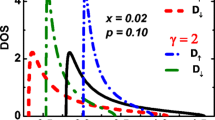Abstract
A low-temperature (3–100 K) electron spin resonance (ESR) study of the spin system of neutral As donors in Ge showed that on the insulator side of the insulator-metal transition the single-spin density exponentially disappears as T → 0. Such spins are bound into pairs to give an antiferromagnetic (AF) phase. Upon increasing the temperature the AF phase is destroyed, the single-spin density and, as a result, the ESR absorption signal becomes stronger. The temperature dependences of the densities of the pairs and single spins are typical for a chaotic distribution of neutral donors. In this case, there is no Néel temperature. For a low degree of compensation, the crystal lattice of Ge with the AF phase is actually a nanostructured system characterized by anisotropic internal stresses that are the strongest along one of the [110] directions. These stresses give rise to the anisotropy of the g-factor which is responsible for experimentally observed splitting of the ESR line. The compensating impurities destroy the AF phase and reduce this splitting. Local stresses are present in this case, too, but now they appear because of the Coulomb interaction of oppositely charged impurities and have no preferred orientation.
Similar content being viewed by others
References
Ludwig, G., Woodbury, H., in: Seitz, F., Turnbull, D. (eds.) Solid State Physics, vol. 13. Academic Press, New York (1962)
Shklovskii, B.I., Efros, A.L.: Electron Properties of Doped Semiconductors. Springer, Heidelberg (1984)
Zabrodskii, A.G.: Sov. Phys. Semicond. 14, 1492 (1980)
Morigaki, K., Maekava, S.: J. Phys. Soc. Jpn. 32, 462 (1972)
Veinger, A.I., Zabrodskii, A.G., Tisnek, T.V.: Semiconductors 34, 45 (2000)
Zabrodskii, A.G.: Phys. Status Solidi B 241, 33 (2004)
Veinger, I., Zabrodskii, A.G., Tisnek, T.V., Golosahchapov, S.I., Mokhov, E.N.: Phys. Status Solidi C 3, 347 (2006)
Lampert, M., Mark, P.: Current Injection in Solids. Academic Press, New York (1970)
Wilson, D.K.: Phys. Rev. 134, A265 (1964)
Author information
Authors and Affiliations
Corresponding author
Rights and permissions
About this article
Cite this article
Zabrodskii, A.G., Veinger, A.I., Tisnek, T.V. et al. Antiferromagnetic spin glass in doped Ge near insulator-metal transition. Appl Magn Reson 35, 439–448 (2009). https://doi.org/10.1007/s00723-009-0175-3
Received:
Revised:
Published:
Issue Date:
DOI: https://doi.org/10.1007/s00723-009-0175-3




